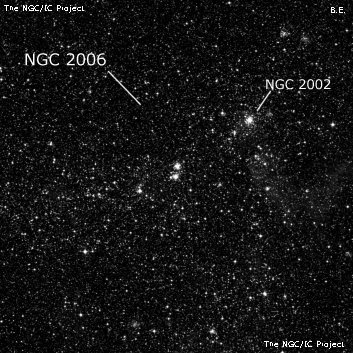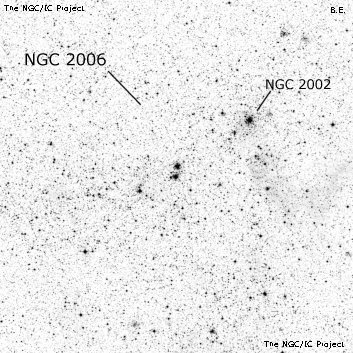NGC/IC Project Restoration Effort
(This is a very very beta version)
NGC2006


Basic Information
Location and Magnitude
Right Ascension: 5:31:19.6
Declination: -66:58:19
Constellation: DOR
Visual Magnitude: 11.5
Historic Information
Discoverer: Herschel J.
Year of discovery: 1834
Discovery aperture: 18.3
Observational
Summary description: Cl, eL, vRi, vBvSNM
Sub-type: OCL
Corwin's Notes
=====
NGC 2006. Brian Skiff has recently (July 2006) called this "cluster" in the
LMC to my attention. At the NGC position there are actually two very small,
compact clusters, probably both globulars. Brian noted that the northern is
certainly [SL63] 538, while the southern is almost always called "NGC 2006".
Mati Morel and Jenni Kay certainly do this in their Atlases, as does Brent
Archinal in "Star Clusters" and Andris Lauberts in ESO.
But when I looked at JH's observations, I found a very different story. Here
is what I wrote to Brian:
JH has two observations for N2006 (precessed to J2000):
05 31 19.4 -66 57 27 A very small nuclear knot in an extremely rich
assemblage of stars and clustering groups which
fill the field. 1834 Dec 23
05 31 18.2 -66 59 11 A small highly condensed knot in an immensely large
and very rich cluster, which fills much more than
the field, and is like the Milky Way. 1837 Jan 03
He clearly saw the same (large!) thing both times. The position for the
first more or less corresponds to the northern cluster, and that for the
second to the southern. So, I think that he either did not separate the two
-- unlikely, since you saw both clusters with a much smaller telescope -- or
he was so impressed by the much larger background star cloud that he simply
took both clusters to be a part of it. It is curious, though, that he
didn't mention the "knot" as a double object.
Looking at the field on the DSS, I would guess that JH's "object" goes all
the way to include NGC 2002 to the northwest, and a similar distance to the
southeast [roughly 15 arcmin by 7 arcmin]. I don't think that it extends as
far southwest or northeast, though JH does not mention any particular
elongation.
So, I'm pretty sure that the JH/GC/NGC numbers are meant to include both
clusters and much more of the Large Cloud besides.
Though Brian suggests keeping the southern cluster as NGC 2006 for consistency
with the modern literature, I've included both clusters in the position list
with notes (hopefully) clarifying the identification. I've also adopted the
rounded mean position of the two clusters for "NGC 2006" itself.
After reading the above note in November 2013, Mati wrote to say that JH's
extended object can be identified with the OB association Lucke-Hodge 771.
There are probably other of these associations that can be picked out of JH's
notes as well, so I will keep my eyes open for them.
Steve's Notes
=====
NGC 2006
24" (4/7/08 - Magellan Observatory, Australia): forms the southern member of a close pair of small clusters (a double cluster!) with SL-538 less than 1' N. At 346x it appeared fairly bright, fairly small, ~30" diameter, brighter core, with no evident resolution. Forms a small triangle with two stars on the east side. Located 8' SE of NGC 2002.
Just 0.9' N is S-L 538, a small, moderately bright glow that is sandwiched between a brighter star at the east edge and a fainter star off the west side. At 346x the shape appeared irregular and ~25" diameter. Interestingly, John Herschel's two positions for NGC 2006 on different sweeps correspond closely with each cluster, so he apparently viewed both (quite similar in the eyepiece) and NGC 2006 should apply to the pair. Herschel didn't note this object as double, though, so he noted this object was the central part of the "extremely rich assemblage of stars and clustering groups which fill the field." NGC 2006 is on the western side of the huge OB association LH 77, an arcing group of clusters and stars stretching 40' E-W and including NGC 2002, 2027 and 2041 and collectively dubbed the "Quadrant Arc".



